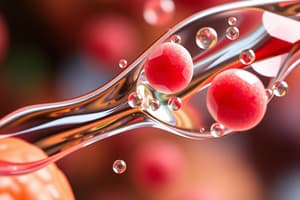Podcast
Questions and Answers
What is the primary characteristic of diffusion?
What is the primary characteristic of diffusion?
- Uses protein channels for transport
- Requires energy from ATP
- Movement against the concentration gradient
- Movement from higher to lower concentration (correct)
What is osmosis specifically the diffusion of?
What is osmosis specifically the diffusion of?
- Glucose
- Proteins
- Water (correct)
- Ions
Which type of transport requires energy to move substances?
Which type of transport requires energy to move substances?
- Osmosis
- Active transport (correct)
- Simple diffusion
- Facilitated diffusion
What is the process by which a cell engulfs large particles called?
What is the process by which a cell engulfs large particles called?
What does a hypertonic solution contain compared to another solution?
What does a hypertonic solution contain compared to another solution?
What is the role of protein pumps in active transport?
What is the role of protein pumps in active transport?
Which of the following describes isotonic solutions?
Which of the following describes isotonic solutions?
What distinguishes exocytosis from endocytosis?
What distinguishes exocytosis from endocytosis?
Study Notes
Transport Mechanisms
- Diffusion is the movement of substances from a region of higher concentration to a region of lower concentration.
- Simple Diffusion does not require energy and allows small, non-polar molecules to pass through the cell membrane.
- Facilitated Diffusion uses helper proteins embedded in the phospholipid bilayer to transport larger, charged, or polar molecules across the membrane.
- Osmosis is the diffusion of water across a semi-permeable membrane.
Hypertonic, Hypotonic, and Isotonic Solutions
- Hypertonic solutions have a higher solute concentration compared to another solution.
- Hypotonic solutions have a lower solute concentration compared to another solution.
- Isotonic solutions have equal solute concentrations.
Active Transport
- Active transport moves substances against their concentration gradient (from a lower concentration to a higher concentration), requiring energy from ATP.
- Examples of active transport include:
- Protein Pumps: These transport proteins use energy from ATP to move specific molecules across the membrane.
- Calcium Pumps: move calcium ions against their concentration gradient.
- Protein Pumps: These transport proteins use energy from ATP to move specific molecules across the membrane.
Types of Active Transport
- Endocytosis: Taking in large particles or fluids into the cell.
- Phagocytosis: Cell engulfs large particles forming a phagosome.
- Pinocytosis: Cell takes in extracellular fluid and solutes via small vesicles.
- Exocytosis: Releasing large molecules from the cell to the exterior.
Studying That Suits You
Use AI to generate personalized quizzes and flashcards to suit your learning preferences.
Related Documents
Description
Test your knowledge on various transport mechanisms including diffusion, osmosis, and active transport. This quiz covers key concepts such as hypertonic, hypotonic, and isotonic solutions, as well as differences between simple and facilitated diffusion. Challenge yourself and deepen your understanding of cellular processes!




